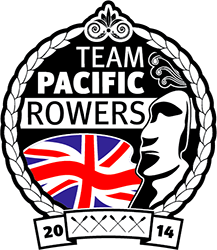With only 5 months to go before the start of the Great Pacific Race, we (and I’m sure all of the GPR crews) have been avidly following the Talisker Whisky Atlantic Challenge which is currently underway, taking crews from the Canary Islands off the north west coast of Africa to Antigua.
14 crews left La Gomera 32 days ago only to be hit by weeks of storms and heavy seas which saw numerous capsizes, resulting in shaken crews, cuts and bruises, equipment loss and failure and in a few extreme cases, teams have had to be airlifted to safety, leaving their boats bobbing around in the Atlantic.
Crews have had to spend days locked in their hot, humid and cramped cabins with their parachute anchors out to keep safe from the seas. Emerging from the cabin when the weather permitted would find them having to reclaim lost miles.
Following along with the highs and the lows of the Atlantic crews really does put things into perspective. It’s very easy to get lost in the romance and excitement of 5/6 weeks at sea rowing from California to Hawaii. My mind is filled with thoughts of celebrations at achieving milestones, the sun rises, the sunsets, the starscapes, the pods of dolphins following us for days, the whales breaching next to us, the banter with 3 good friends and all the other highs we will experience as we chase the sun west. It is good then, that we are brought back to reality so we don’t get carried away. We are reminded that it won’t all be joyous. We’ll experience sores all over our hands, feet and bodies, exhaustion, sleep deprivation, unbearable heat and cramped conditions. At times we will even be in fear of our lives.
A capsize, now seems a probability rather than a freak 1 in 1000 occurrence as I previously perceived it to be. I don’t think there is a single crew on the Atlantic Challenge who hasn’t experienced one yet. With the capsizes, along with equipment being lost to the sea, many of the Atlantic crews are reporting electrical failures due to water getting into the systems.
An electrical failure has now moved from completely off my radar to my current biggest worry. If the electrics fail, we won’t be able to make water. If we had no water we’d have to pull out of the race. I’ll be the first to admit that I’m not much of a handyman, if we needed to start rewiring the electronics to get the watermaker functioning, I wouldn’t have a clue where to start.
Luckily, we have a manual for our wiring system on board. I’ll surely be spending a lot of time on the boat with a knowledgable friend to show me at the very least the basics before we set off.
One of the teams has even reported being attacked by a shark (or possibly swordfish) a few days ago. It seems the shark attempted a few taster bites before realising that the boat was inedible and moved on. Not before leaving a hole and one of it’s teeth in their hull. Any of my friends who have been swimming with me in the sea will tell you that I’m the first one to race back to shore if I see anything on the sea floor that isn’t untouched sand.
Following the Atlantic race really has been an eye opener. I’ve been glued to the race tracker and eagerly read each of the crews’ blog updates the second they fall into my Feedly account. The event organisers have done an amazing job with the coverage of the race and I look forward to similar coverage of our race.
Despite all the harsh realities that the Atlantic Updates have brought, they have also made me even more excited and impatient to make that first push off from the pontoon in Monterey.


